A New Comet, Exploring the Fullish Moon’s Western Wastes, the Moon Covers Uranus, Mounting Meteors, and Mars Menaces a Crab!
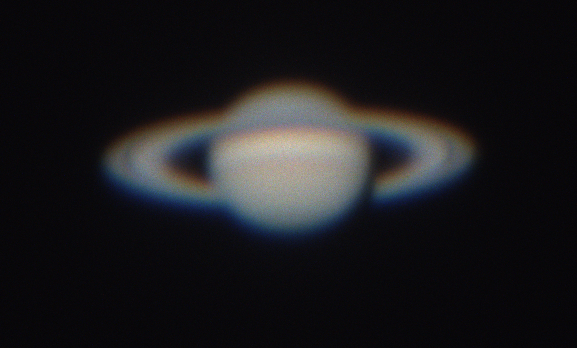
I took this unprocessed image of Saturn through the 74″ (1.88 metre) diameter telescope at the David Dunlap Observatory in Richmond Hill, Ontario at 9:13 pm EDT on October 3, 2022. Note the bands on the planet, and the dark Cassini Division that separates the outer from the inner rings. The wedge of shadow cast onto the rings by Saturn’s globe is visible at lower right. The telescope’s optical path rotated the view by 180 degrees.
Hello, fellow moon-lovers!
Here are your Astronomy Skylights for the week of October 9th, 2022 by Chris Vaughan. Feel free to pass this along to your friends and send me your comments, questions, and suggested topics. You can also follow me on Twitter as @astrogeoguy! Unless otherwise noted, all times are expressed in Eastern Time. To subscribe to these emails please click this MailChimp link.
If you’d like me to bring my Digital Starlab portable inflatable planetarium to your school or other daytime or evening event, or deliver a session online, contact me through AstroGeo.ca, and we’ll tour the Universe, or the Earth’s interior, together! My terrific book with John A. Read entitled 110 Things to See With a Telescope is a guide to viewing the deep sky objects in the Messier List – for both beginners and seasoned astronomers. DM me to order a signed copy!
This week the moon will dominate the night sky as it wanes from Sunday’s Full Hunter’s moon – so we focus on some features to view on the moon’s western half. The moon will pass in front of Uranus on Tuesday for many observers. In the evening sky, Mars will approach the Crab Nebula, and spots will cross bright Jupiter. Finally, a new comet is available for larger telescopes, and Orionids meteors begin to appear. Read on for your Skylights!
A New Comet for Telescopes and Imagers
A recently discovered comet named c/2022 E3 (ZTF) is predicted to become bright enough to see in binoculars next February. For now, it is still very far away, but is visible in 8” or larger telescopes during evening. This week comet ZTF will travel through the left-hand (or southeastern) part of the constellation of Corona Borealis (the Northern Crown). That constellation occupies the lower third of the western sky after dusk, below Hercules and above the bright star Arcturus.

Tonight (Sunday) the comet will sit just to the right of the midpoint between the medium-bright stars Delta and Epsilon Coronae Borealis. On Thursday and Friday it will fly between those stars, but closer to the lower star, Delta. Next Sunday night it will be positioned just to the upper left (or celestial east) of Delta, close enough to share the view in a telescope.
The comet will remain near the boundary between Corona Borealis and Serpens (the Snake) for the next two months, but those stars will eventually be overwhelmed by the evening twilight – so make your attempts to see the comet sooner than later. In a telescope this week, expect the comet to appear as a small fuzzy patch of magnitude 11.7. Any tail it might have will point up, though your telescope may flip the view.
The Moon
The moon will dominate the night sky worldwide for much of this week. Today (Sunday) at 4:55 pm EDT (or 1:55 pm PDT or 20:55 GMT), the moon will officially reach its full phase. The October full moon is traditionally called the Hunter’s Moon and, appropriately for Halloween season, the Blood Moon, or Sanguine Moon. (Not to be confused with an eclipsed “blood moon”. One of those is coming on November 8!) Last week here, I wrote more about this full moon and things to ponder while you are gazing upon Earth’s fully lit natural satellite.
Since the moon will still be more or less opposite the sun in the sky for the next couple of days, the early sunsets of October (about 2 minutes earlier each day) will bring the moon into view over the eastern horizon before the bedtimes of the junior astronomers. Take them out for a look!
The bright moon will shine among the faint stars of Pisces (the Fishes) on Sunday and Monday. On Tuesday night, the waning gibbous moon will be approaching the blue-green, magnitude 5.7 speck of Uranus in southern Aries (the Ram). In the Eastern Time Zone after dusk, Uranus will sit about three finger widths to the moon’s lower left. Unfortunately, the bright moonlight will make seeing Uranus difficult. Folks looking later, or from more westerly time zones, will see the moon a lot closer. Around 2 am EDT or 06:00 GMT, telescope-owners in the northwestern USA, Alaska, northern and western Canada, and Greenland can see the moon pass in front of (or occult) Uranus – the tenth in a series of consecutive lunar occultations of that planet. The rest of North America will only see the moon pass closely above (north) of Uranus.
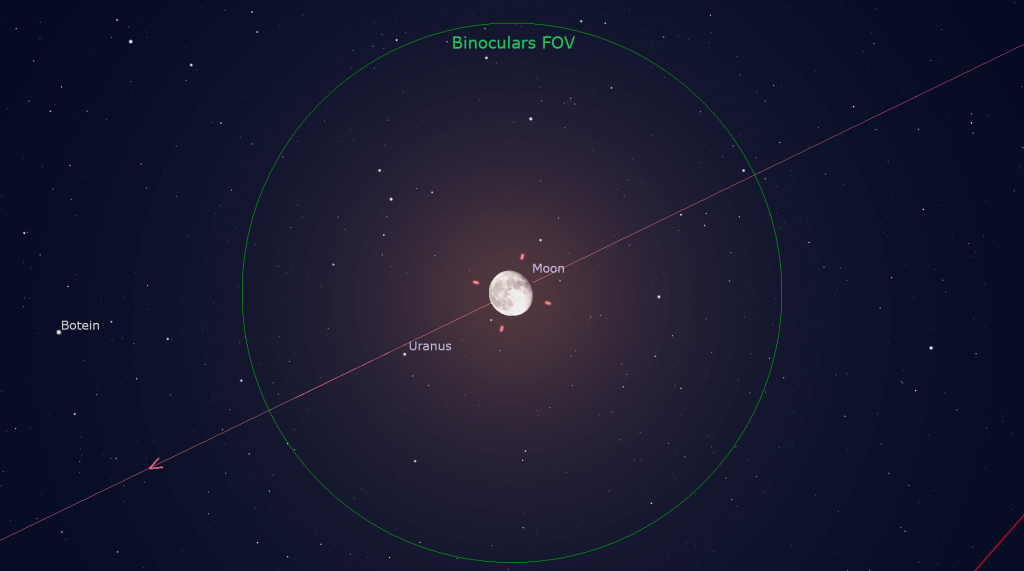
The first few nights of this week will be ideal for exploring the western half of the moon. It is dominated by the large and irregular Oceanus Procellarum, the Ocean of Storms, and round Mare Imbrium, the Sea of Rains, which adjoins Procellarum to the upper right (or lunar northeast). Both are ancient basins that were excavated by huge impactors and later flooded with dark, iron-rich basalts that upwelled from the moon’s interior. The dark lunar maria are far less cratered than the bright highlands, but they are not featureless. Binoculars and telescope views reveal that the basalts vary in color and darkness due to their chemistry. When the lunar terminator is near a mare, slanted sunlight casts shadows from curved wrinkle ridges that ring each mare’s interior.

Three prominent craters break up the expanse of Oceanus Procellarum. Large Copernicus is the easternmost. Its extensive, ragged ray system intermingles with the rays of smaller crater Kepler to its southwest. The very bright crater Aristarchus positioned to the upper left (lunar northwest) of them occupies the southeastern corner of a diamond-shaped plateau that is one of the most colorful regions on the moon. NASA orbiters have detected high levels of radioactive radon there. Use a telescope and high magnification to view features like the large, sinuous rille named Vallis Schröteri. Its snake-like form begins between Aristarchus and next-door crater Herodotus and slithers across the plateau.
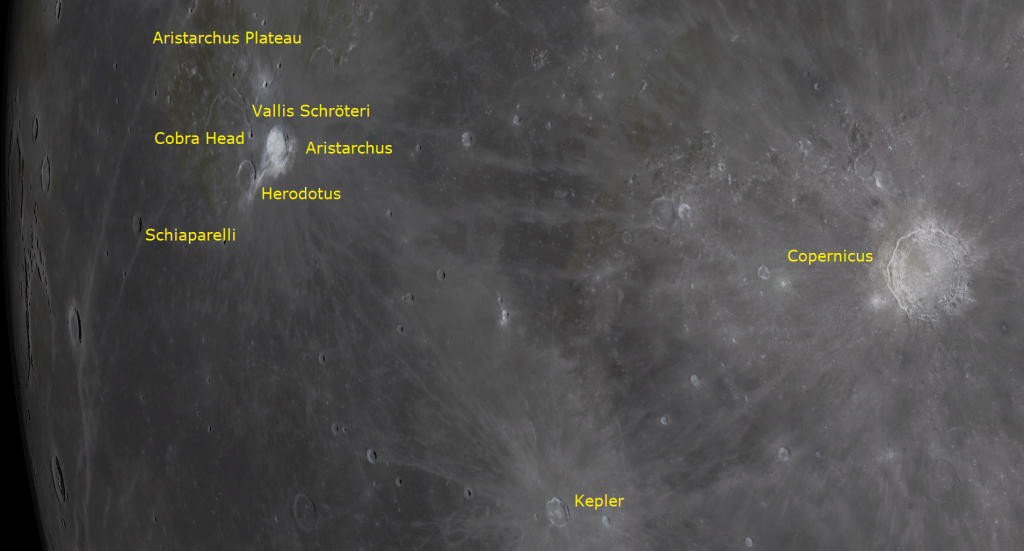
The Reiner Gamma Lunar Swirl is a small, high-albedo (i.e., light in colour) area located just inside the western edge of Procellarum, above (due north) of the dark, round crater Grimaldi and to the left (due west) of Kepler. It is best seen a night or two after the moon’s full phase. The easily seen 30 km diameter crater of Reiner is located a short hop to the right (east-southeast) of Reiner Gamma. The swirl is composed of ancient lunar basalt that has not been darkened by weathering, likely due to protection from cosmic rays by a strong localized magnetic field – the swirl has one of the strongest magnetic anomalies on the moon! At high magnification, its complex, fish-like shape is fascinating. Take a look!
From Wednesday to Friday the moon will traverse the length of Taurus (the Bull). On Wednesday night, the Pleiades Star Cluster, a mere thumb’s width in length, will be positioned several finger widths to the upper left (or 3.5 degrees to the celestial north) of the moon. On Thursday the moon will shine a palm’s width to the upper left of Taurus’ brightest star, Aldebaran. And on Friday, the moon will visit the bright, reddish dot of Mars. The Moon and Mars will be close enough to share the view in binoculars (green circle) all night long – but, by sunrise, the moon will be farther from and directly above the planet. All night long, watch for the bright, yellow, sun-like star Capella sparkling above the moon.
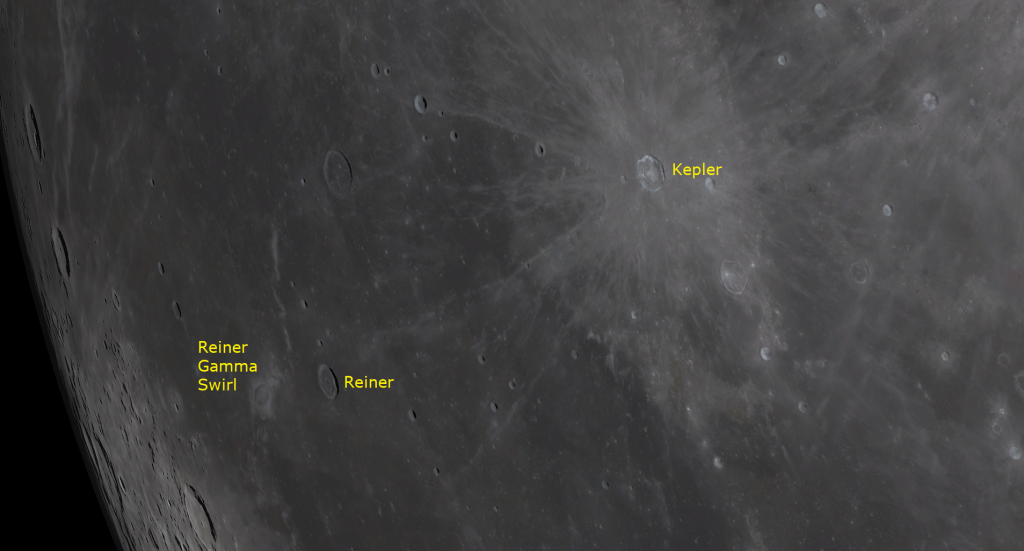
The moon will spend the coming weekend among the stars of Gemini (the Twins), but you’ll need to stay up until midnight and beyond, or look south before dawn, to see it. Once the half-moon rises around 11 pm local time on Sunday, it will form a pretty triangle to the right (or celestial southwest) of the up-down pair of Gemini’s brightest stars, Castor and Pollux. During the night, the moon’s easterly orbital motion will carry it closer to Pollux (the lower, more easterly star), allowing all three objects to share the view in binoculars on Monday morning until dawn.
The Planets
Only yesterday (Saturday, October 8), Mercury reached its greatest angle from the sun and peak visibility from mid-northern latitudes for its current apparition. With Mercury rising almost 90 minutes before the sun, it will be easy to see shining above the eastern horizon before sunrise this week. Try to look for it around 6:30 am, when the stars of Leo (the Lion) should be visible above it in a relatively dark sky. By 7 am local time, Mercury will be higher, but the sky will be brightening. In a telescope Mercury will exhibit a waxing gibbous phase – but turn your optics away from the east before the sun rises. Mercury’s position beside the nearly upright morning ecliptic is making this an excellent apparition for Northern Hemisphere observers, but a very poor one for those located south of the Equator, where the ecliptic and Mercury’s orbit are more horizontal.
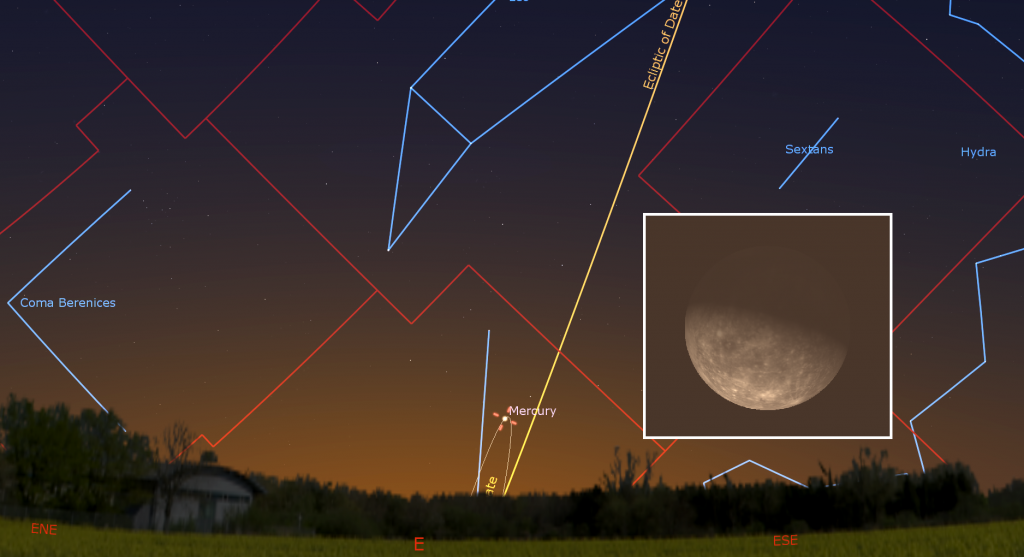
The rest of the planets are in the evening and late-night sky. The early sunsets will let us see the creamy yellow dot of Saturn shining in the lower part of the southeastern sky, and much brighter, whiter Jupiter gleaming above the east-southeastern horizon, as early as 7:30 pm local time. The two gas giant planets will cross the sky from east to west during much of the night – until Saturn sinks below the trees in the west after 1 am local time. Jupiter will follow it down around 5:30 am. When red Mars joins the party around 10 pm, all three bright planets will be in view – with Mars climbing to sit high in the southern sky before dawn.
Planets look clearest in telescopes when they are higher in the sky. When they are there, you are not peering through as much intervening, turbulent air. Because of their positions in the autumn zodiac constellations, Saturn and Jupiter won’t climb very high in the sky this year. Mars, however, will be nice and high in the sky for its peak in early December. Over the next several years, Jupiter will migrate eastward into the constellations that climb higher. Its 12-year orbit of the sun shifts Jupiter by one zodiac constellation each year. Saturn will do the same, but half as quickly. Its orbital period is 30 years. This week, Saturn will be highest around 9:30 pm local time, while Jupiter will be highest at midnight -but you can view them any time.
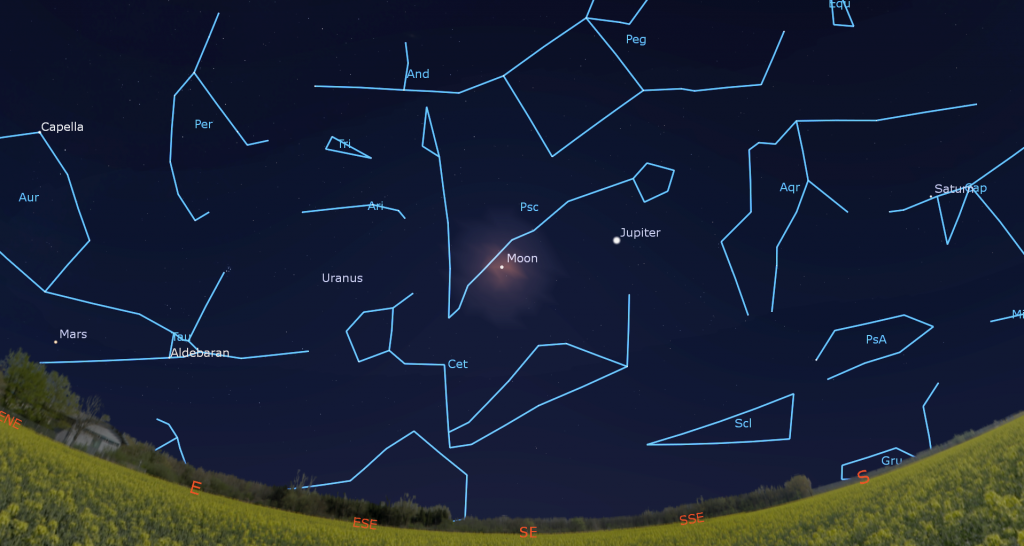
If you’ve been reading Skylights for a while, you know that a retrograde loop has carried Saturn slowly westward compared to the medium-bright stars of Capricornus (the Sea-Goat) below it. In August, it was perched above the brighter tail stars of the sea-goat. Since then it has been shifting toward the star Iota Cap. You can use your unaided eyes, binoculars or any telescope to see Saturn and that star get cosier every night. But Saturn’s loop is ending this month. On October 22, the pair will be closest together. Then they’ll steadily widen.
Even a small telescope will show Saturn’s subtly banded globe encircled by its glorious rings, which are sufficiently edge-on to us to allow Saturn’s southern polar region to extend well beyond the ring plane. See if you can see the Cassini Division, the narrow, dark gap that separates Saturn’s main inner ring (named B) from its bright outer one (named A). Saturn’s position west of the anti-solar point has caused the planet’s globe to cast a widening wedge of dark shadow onto the rings where they emerge from behind the eastern limb of the planet. Where you see that shadow will depend upon how your telescope flips and/or mirrors the view. In a refractor or SCT telescope, it’s toward the upper right. In a Newtonian reflector, it will be toward lower right. An equatorial mount will rotate the scene, too. To best see Saturn’s features, take long looks and wait for moments of perfect clarity.
A small telescope can also show several of Saturn’s moons – especially its largest, brightest moon, Titan! From here on Earth, Saturn’s axial tilt of 26.7° lets us see the top of its ring plane, and allows its brighter moons to array themselves all around the planet. Titan never wanders more than five times the width of Saturn’s rings from the planet. The much fainter moon named Iapetus can stray up to twelve times the rings’ width during its 80-day orbit of Saturn. The next brightest moons Rhea, Dione, Tethys, Enceladus, and Mimas all stay within one ring-width of Saturn. During evening this week, Titan will migrate counter-clockwise around Saturn, moving from the left (or celestial east) of Saturn tonight (Sunday) to the lower right (or celestial southwest) of the planet next Sunday. (Remember that your telescope might flip that view around.) How many of the moons can you see in your telescope?
Switching to Jupiter, good binoculars will show Jupiter’s disk (three times bigger than Saturn’s) flanked by its row of four Galilean moons named Io, Europa, Ganymede, and Callisto. Those moons complete orbits of the planet every 1.7, 3.6, 7.2, and 16.7 days, respectively. If you see fewer than four moons, then one or more of them is crossing in front of or behind Jupiter – or lurking in Jupiter’s dark shadow – or two moons are occulting one another. Any size of telescope will show Jupiter’s dark belts and light bands running parallel its equator.
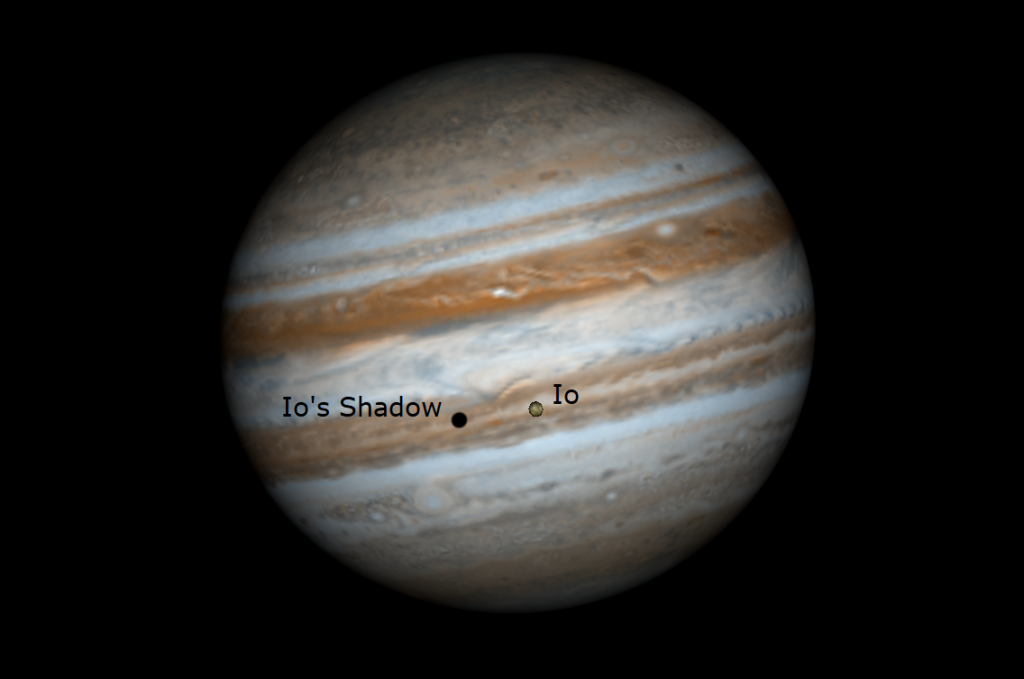
Because Jupiter rotates once every 10 Earth-hours, anyone can use a good backyard telescope to watch the pale-looking Great Red Spot cross the planet every 2nd or 3rd night. For observers in the Americas, the GRS will cross Jupiter’s disk in early evening on Thursday and Saturday, late on Monday and Wednesday evening, and during the wee hours of Monday, Wednesday, and Saturday. If you have any coloured filters for your telescope, try enhancing the GRS with them.
The small, black shadows of Jupiter’s Galilean moons are visible through a good backyard telescope when they cross the planet’s disk. For observers in the America’s, Io’s shadow will cross Jupiter’s equator on Sunday night, October 9 between 8:15 pm and 10:25 pm EDT. It will cross again on Saturday morning from 3:40 am and 5:40 am EDT. On Sunday morning, October 16 between 12:00 am and 2:30 am EDT, the small, black shadow of Europa will cross the southern half of Jupiter’s disk. Don’t forget to adjust these quoted times into your own time zone.

This week, Mars will deliver reasonable views in a backyard telescope after 11:30 pm local time – but that time will rapidly shift earlier over the coming weeks. In a telescope, Mars will show an 89%-illuminated disk, with hints of the dark markings that will sharpen up as Earth’s faster orbit draws us closer to the red planet over the coming months. We’re 109 million km (or 6.1 light-minutes) away from it this week. Watch for the bright reddish star Aldebaran twinkling 1.4 fist widths to Mars’ upper right (or celestial southwest) and bright yellow Capella shining 2.3 fists to the upper left (or celestial north).
For about ten nights surrounding Saturday, October 15, the easterly motion of Mars will carry it closely past the Crab Nebula, otherwise known as Messier 1 and NGC 1952, in Taurus. Mars will move to within a thumb’s width above (or 1.5 degrees to the celestial northwest of) M1 on Tuesday, October 11 – just close enough to share the view in a backyard telescope. At their closest approach on Saturday, Mars will be positioned about a finger’s width to the upper left of the magnitude 8.4 supernova remnant. On the following nights, Mars will shift more to the nebula’s upper left (or northeast). The relatively faint and fuzzy oval of the Crab Nebula is best viewed in larger telescopes under dark skies – and when it is higher in the sky during the wee hours. Since the waning moon will pass close to the pair on Friday, October 14, it might be better to view the pair next week, before the crescent moon rises on October 17-20.
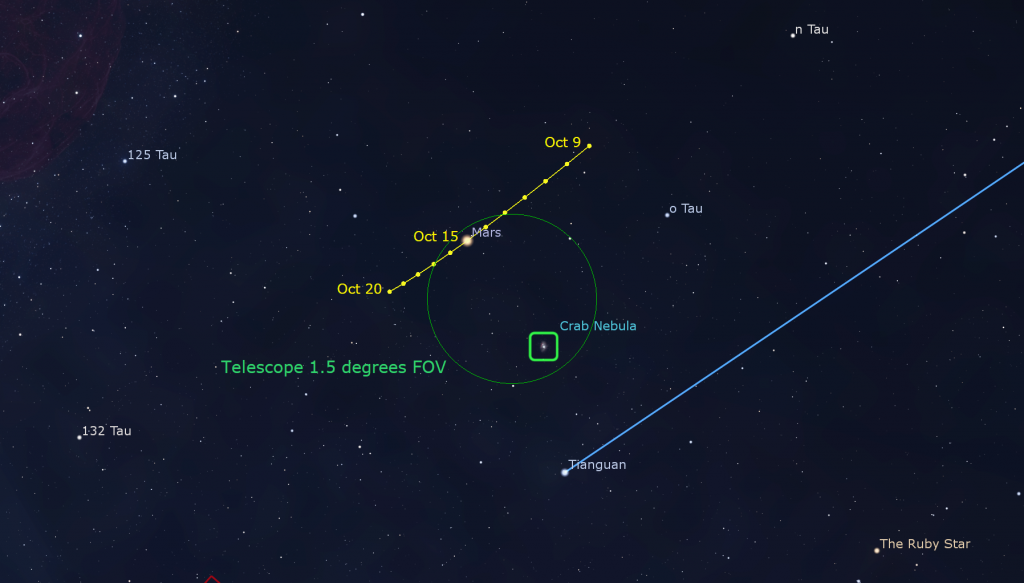
So much for the bright easy planets – what about the fainter ones?
The main belt asteroid designated (4) Vesta and the blue planet Neptune are within reach of binoculars and backyard telescopes in a dark sky. Magnitude 6.68 Vesta is located 0.9 fist diameters to the lower left of Saturn, and a palm’s width from the two medium-bright stars Yen (aka Zeta Capricorni) and Deneb Algedi (aka Delta Capricorni). Magnitude 7.8 Neptune is located 0.9 fist widths to the right (or 9° to the celestial south-southwest) of Jupiter, which will slide a wee bit closer to the distant planet every night. Still close to opposition for 2022, Neptune’s apparent disk size is 2.4 arc-seconds and its large moon Triton is still visible. Try for these while they are highest in late evening.

Uranus is located 1.3 fist widths to the upper right (or 13° to the celestial west-southwest) of the Pleiades star cluster. Closer guideposts to Uranus are several medium-bright stars named Botein (or Delta Arietis), Al Butain II (or Rho Arietis), and Sigma Arietis which will appear several finger widths from Uranus. Those stars mark the feet of the Aries (the Ram). The magnitude 5.7 planet will be high enough for telescope-viewing, in the lower part of the eastern sky, by 10 pm local time this week – but the bright moon will buzz it on Tuesday, as I described above. (Don’t skip the moon section!)

Orionids Meteor Shower
We’ve entered meteor shower season! Over the next few months, Earth will experience several showers. My friend Blake Nancarrow created a very informative graph of meteor shower intensity throughout the year here, on his Lumpy Darkness blog.
The excellent Orionids Meteor Shower, which is observable world-wide, happens every year between September 23 and November 27. That’s when Earth is plowing through a cloud of fine particles dropped by repeated past passages of the periodic comet designated 1P/Halley, or simply Halley’s Comet. The Orionids (for short) will peak in the hours before dawn (in your local time zone) next Friday, October 21. At that time, the sky overhead will be pointing toward the densest region of the particle field, generating as many as 10-20 meteors per hour. Although not particularly numerous, Orionids are known for being bright and fast-moving.
Moon-wise, this will be a good year for that shower. I’ll write more about the Orionids next week. For now, keep an eye to the skies!
Some Double Stars You Can See in Binoculars
If you missed last week’s information about double stars that are easy to observe in October, I posted it with star charts here.
Public Astro-Themed Events
Every Monday evening, York University’s Allan I. Carswell Observatory runs an online star party – broadcasting views from four telescopes/cameras, answering viewer questions, and taking requests! Details are here. They host in-person viewing on the first clear Wednesday night each month. Other Wednesdays they stream views online via the observatory YouTube channel. Details are here.
My free, family-friendly Insider’s Guide to the Galaxy webcasts with Samantha Jewett of RASC National returns on Tuesday, October 11 at 3:30 pm EDT. The little constellation of Delphinus, the Dolphin, swims the autumn evening sky. It is easy to identify with unaided eyes, can be explored in binoculars, and has lots of interesting stars and deep sky targets for telescopes of any size. We’ll dive into Delphinus and then complete the final handful of Messier objects in our Messier Minutes segment. You can find more details and the schedule of future sessions here.
On Thursday, October 13 from 7:30 to 9 pm, Space Place Canada will present a free online talk by Professor Ramani Ramakrishnan, former chief acoustician of NASA. His talk is entitled NASA’s Largest & Loudest Test Chamber. Details and the Eventbrite link are here.
On Saturday, October 15, 2022 from 11 am to 5 pm, astronomers from the RASC Toronto Centre will participate in the hugely popular, entertaining, and free Pumpkinville Festival, which is held by the Town of Ajax at beautiful Greenwood Conservation Area. In addition to an information tent, RASC will set-up special telescopes to view the sun up close! Details and maps are here.
RASC’s Public sessions at the David Dunlap Observatory will soon be resuming! In the meantime they are pleased to offer some virtual experiences instead in partnership with Richmond Hill. The modest fee supports RASC’s education and public outreach efforts at DDO. Only one registration per household is required. Prior to the start of the program, registrants will be emailed the virtual program link.
On Friday, October 14 from 7:30 to 9 pm EDT, the online DDO Astronomy Speakers Night program will feature Julie Claveau, Program Officer for smartEarth at the Canadian Space Agency (CSA) and also Co-Chair of the CSA’s Women in STEM committee. She’ll speak on Canada’s Role in the James Webb Space Telescope Mission. There will also be a virtual tour of the DDO and live-streamed views from the DDO’s 74-Inch telescope (weather permitting). The deadline to register for this program is Wednesday, October 12, 2022 at 4 pm. More information is here and the registration link is here.
On Sunday, October 16 from 12:30 to 1 pm EDT, tune in for DDO Sunday Sungazing. Safely observe the sun with RASC, from the comfort of your home! During these family-friendly sessions, a DDO Astronomer will answer your questions about our closest star: the sun! Learn how the sun works and how it affects our home planet. Live-streamed views of the sun through small telescopes will be included, weather permitting. Only one registration per household is required. Deadline to register for this program is Wednesday, October 12, 2022 at 3 pm. Prior to the start of the program, registrants will be emailed the virtual program links. More information is here and the registration link is here.
Space Station Flyovers
The ISS (or International Space Station) will not be visible over the GTA this week.
Keep looking up, and enjoy the sky when you do. I love questions and requests. Send me some!